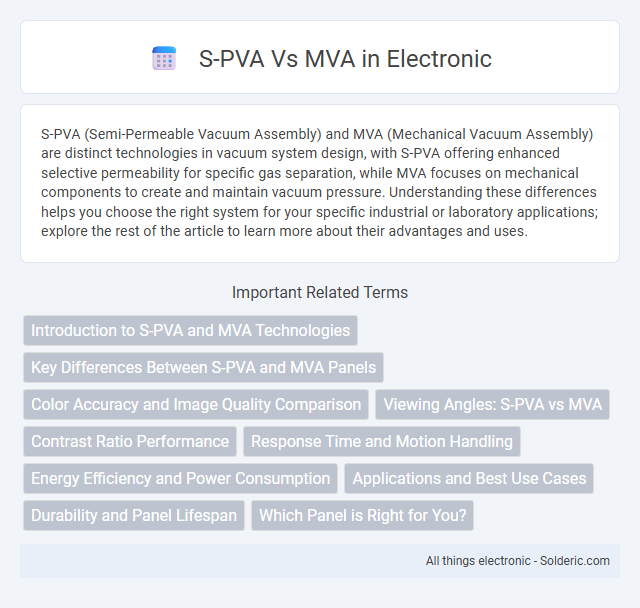S-PVA (Semi-Permeable Vacuum Assembly) and MVA (Mechanical Vacuum Assembly) are distinct technologies in vacuum system design, with S-PVA offering enhanced selective permeability for specific gas separation, while MVA focuses on mechanical components to create and maintain vacuum pressure. Understanding these differences helps you choose the right system for your specific industrial or laboratory applications; explore the rest of the article to learn more about their advantages and uses.
Comparison Table
| Feature | S-PVA (Super PVA) | MVA (Multi-domain Vertical Alignment) |
|---|---|---|
| Display Type | LCD with flexible molecular alignment | LCD with vertical alignment technology |
| Viewing Angles | Wide viewing angles (~178deg) | Improved over standard VA, but narrower than S-PVA |
| Contrast Ratio | High (~3000:1) | Very high (up to 5000:1) |
| Response Time | Moderate | Faster due to multi-domain alignment |
| Color Accuracy | Good | Better due to multi-domain improvements |
| Black Levels | Deep blacks | Deeper blacks than S-PVA |
| Usage | General purpose, high-quality displays | High-end monitors, professional use |
Introduction to S-PVA and MVA Technologies
Spherical Polyvinyl Alcohol (S-PVA) and Monofilament Viscose Acetate (MVA) are advanced fiber technologies used predominantly in textile and industrial applications. S-PVA features a unique spherical structure that enhances water retention, tensile strength, and biodegradability, making it ideal for eco-friendly products. MVA fibers are characterized by their smooth, monofilament form, offering superior moisture absorption, tensile durability, and versatility in applications like filtration and medical textiles.
Key Differences Between S-PVA and MVA Panels
S-PVA panels offer superior color accuracy and wider viewing angles compared to MVA panels, making them ideal for graphic design and professional video work. MVA panels excel in contrast ratios and deeper black levels, providing enhanced performance for media consumption and gaming in low-light environments. Response times are generally faster on S-PVA, while MVA panels tend to have better price-to-performance ratios for general use.
Color Accuracy and Image Quality Comparison
S-PVA panels provide superior color accuracy and wider viewing angles due to their enhanced liquid crystal alignment, resulting in more vibrant and true-to-life images compared to MVA panels. MVA displays typically offer higher contrast ratios, producing deeper blacks but may suffer from color shifting and reduced image clarity when viewed off-center. For your projects demanding precise color fidelity and consistent image quality across various viewing angles, S-PVA technology is often the better choice.
Viewing Angles: S-PVA vs MVA
S-PVA (Super Patterned Vertical Alignment) panels generally offer wider viewing angles compared to standard MVA (Multi-domain Vertical Alignment) panels, with horizontal viewing angles often exceeding 178 degrees. This superior angle consistency minimizes color shift and contrast loss when viewed from off-center positions, making S-PVA ideal for collaborative environments and multi-monitor setups. In contrast, MVA panels tend to exhibit narrower angles and more pronounced color and brightness degradation at extreme viewing positions.
Contrast Ratio Performance
S-PVA panels typically offer higher contrast ratios compared to MVA displays, delivering deeper blacks and more vibrant colors that enhance image quality in dark scenes. The superior liquid crystal alignment in S-PVA technology reduces light leakage, which directly contributes to improved contrast performance. Your choice of an S-PVA monitor ensures better visual depth and richness, especially beneficial for multimedia and gaming applications.
Response Time and Motion Handling
S-PVA panels typically offer faster response times compared to MVA panels, making them better suited for fast-moving content such as gaming and sports. The superior motion handling of S-PVA reduces ghosting and motion blur, enhancing overall image clarity during rapid scenes. In contrast, MVA panels often have slower response times and less effective motion handling, which can result in more noticeable trailing effects.
Energy Efficiency and Power Consumption
S-PVA (Super-Patterned Vertical Alignment) displays demonstrate superior energy efficiency compared to MVA (Multi-domain Vertical Alignment) panels due to their advanced liquid crystal alignment that reduces power consumption during high brightness operation. S-PVA technology optimizes light transmission and minimizes voltage requirements, leading to lower overall energy usage in devices such as monitors and TVs. In contrast, MVA panels often consume more power under similar conditions due to less efficient pixel alignment and greater backlight demands.
Applications and Best Use Cases
S-PVA (Stand-Alone Polyvinyl Alcohol) is ideal for applications requiring water-soluble films, adhesives, and textile sizing due to its excellent film-forming and adhesive properties. MVA (Multi-functional Vinyl Acetate) excels in coatings, adhesives, and packaging, offering enhanced flexibility, adhesion, and durability in composite materials. Choosing between S-PVA and MVA depends on the specific industry demands, with S-PVA favored in water-soluble solutions and MVA preferred for structural strength and versatility in industrial coatings.
Durability and Panel Lifespan
S-PVA films typically offer superior durability compared to MVA panels due to their enhanced resistance to screen burn-in and image retention, resulting in a longer panel lifespan. MVA panels provide solid durability but often experience faster degradation under prolonged static image exposure, which can shorten their effective lifespan. Choosing S-PVA technology can ensure your display maintains consistent performance and visual quality over extended use.
Which Panel is Right for You?
Selecting between S-PVA (Super Patterned Vertical Alignment) and MVA (Multi-domain Vertical Alignment) panels depends on your priorities for color accuracy, viewing angles, and response times. S-PVA panels generally offer better contrast ratios and wider viewing angles, making them ideal for professional photo editing and immersive media consumption. MVA panels provide faster response times and improved black levels, suitable for gaming and general multimedia use where speed and deeper blacks are essential.
S-PVA vs MVA Infographic

 solderic.com
solderic.com